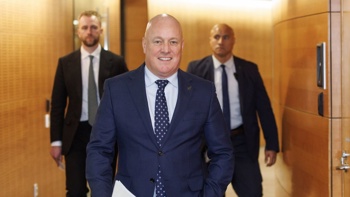Auckland Council chief executive Jim Stabback left council headquarters to go home shortly before 5pm on the night of the Auckland Anniversary floods when the emergency response to the lethal downpour would have been at its peak.
A damning report of the emergency response to the January 27 floods was delivered on Wednesday and is understood to contain numerous references to the absence of senior council leaders at Auckland Council’s city centre headquarters that night.
But the report’s author, former police commissioner Mike Bush, made clear that the report commissioned by Mayor Wayne Brown was not designed to “play the man” and focused on general findings on the dysfunction within Auckland Council leadership and communication.
Nevertheless, it is understood the report’s reference to a lack of “visible leadership” on the night of January 27 was in part a reference to Stabback and others not being at council headquarters on Albert St.
The Herald also understands Auckland Council Group and Stabback sought legal advice over draft sections of the Bush report that led to the extension of the report’s release date.
Originally scheduled for a March 3 release, the report was finally delivered on April 12 - with Bush fronting a press conference alone at Auckland Council headquarters, with neither Mayor Wayne Brown or Stabback in attendance to face the media.
/cloudfront-ap-southeast-2.images.arcpublishing.com/nzme/4U7D5N3KRLCO7O54C2PUEYVTLU.jpg) Jim Stabback, Auckland Council's Chief Executive Officer and Mayor Wayne Brown as Brown started the first day of his term. Photo / NZME
Jim Stabback, Auckland Council's Chief Executive Officer and Mayor Wayne Brown as Brown started the first day of his term. Photo / NZME
Stabback admitted to the Herald he was at home during the evening of January 27 and “with hindsight” would have stayed in the office.
“Throughout the evening of 27 January, I was at home and fully connected into the organisation via my laptop and mobile,” Stabback said.
“Of course, with hindsight, had we known the extent of what was about to unfold between late afternoon and throughout the night, I would have chosen to remain in the office.
“Around 6-6.30pm I considered returning to the office, however that could well have taken over an hour and would have reduced direct contact with Phil [Wilson, governance director] and the organisation during that time.”
/cloudfront-ap-southeast-2.images.arcpublishing.com/nzme/5PMEVINMXRAA5FRLFKDG7XZ7RM.jpg) Former police commissioner Mike Bush at the press conference for the Auckland flood review. Photo / Alex Burton
Former police commissioner Mike Bush at the press conference for the Auckland flood review. Photo / Alex Burton
It’s understood Stabback lives in Parnell - a suburb that borders the central city where Auckland Council’s Albert St headquarters is located.
The chief executive said that while at home he was consulting with the council’s director of governance and CCO partnerships, Phil Wilson, who was onsite, receiving updates and checking on the requirements of the mayor and the mayoral office, including offers to speak with them.
“I have complete trust and confidence in Phil, who was a physical and onsite presence at the office, and we were in direct contact throughout the evening,” Stabback said.
Stabback officially resigned from the top post at the council on February 22 this year - three weeks after the Auckland Anniversary floods. He gave six months’ notice to leave the top job at the council.
Four people lost their lives during the record-breaking downpour that began on the afternoon of January 27.
Mayor Brown was widely criticised for the slowness of his public response to the downpour and the eventual decision to place the Auckland region in a state of emergency after 10pm, when flooding was already widespread across the city.
Swipe card records the Herald obtained via official information reveal Brown was in Council’s Albert St headquarters from 4.08pm on January 27, and left at 12.33am on Saturday, January 28.
/cloudfront-ap-southeast-2.images.arcpublishing.com/nzme/57UT4TYRVRHUTHFCA3LV3N24K4.JPG)
The Herald understands Stabback left the Albert St headquarters about 4.45pm that evening.
A Fire and Emergency New Zealand (Fenz) press release at 5.07pm on Friday said “every fire truck in Auckland is responding to the priority calls” and they were responding to over 400 emergency calls.
Sections of the 107-page Bush review of the flood response also indicate that Stabback was not present at council headquarters to assist with the emergency response in person.
At 4.06pm, Stabback texted Brown that Auckland Emergency Management was supporting Fenz and response agencies re “some flooding in Swans and Ranui”. Stabback said the “weather is expected to abate”.
Then at 7.17pm, Stabback texted Phil Wilson saying: “I have not called the mayor. He is getting updates from Auckland Emergency Management and I’m sure others. Let me know if there is anything we need to do”. The reply from Wilson was: “will do. Lots of scrambling going on...”
At 12.07am on Saturday morning, Brown texted Stabback and Wilson: “We need to meet in my office 830 tomorrow with your leadership group...”. Stabback confirmed that he was present at this 8.30am meeting organised by the mayor.
The Bush report also highlights that the Incident Management Team meetings which were used to advise the mayor and other council officials on the state of the flood emergency were done virtually.
The reason for this was that senior Auckland Council staff weren’t in the Albert St building.
Bush review key findings:
- The council’s emergency management system was unprepared for an event of this magnitude and speed.
- Senior leaders underestimated the importance of the need to be visible, which hampered communications and public confidence.
- There were poor communications in the critical early stages between key players at the council, including the mayor, Civil Defence and Emergency Committee chairwoman Sharon Stewart, chief executive Jim Stabback and emergency management staff.
- The emergency management team appeared to lack the command, crisis and leadership skills to cope with the event.
- The council knew it had to be prepared for a super-storm emergency before January 27, but it remained a work in progress.
- The move to Super City planning for emergencies contributed to a bias that its size and systems could handle anything.
- Rather than a model of central planning and local delivery, the council centralised planning and delivery where local knowledge could have supported communities better.
Among the report’s 17 recommendations were:
- A separate, urgent review to examine AEM’s prevention, preparedness and planning for emergencies.
- Ensure AEM members have the resources, training and capability for internal and external communications.
- Conduct more emergency management exercises, including complex scenarios, with partner agencies and utilities and involving the mayoral office.
- Hire more qualified emergency response staff, including experts in public information.
- Develop a common IT system for emergencies with partner agencies to share information and improve real-time communications and decision-making.
- Establish strong relations with critical stakeholders, including mana whenua, Pasifika, community groups, infrastructure providers and lifeline agencies.
Take your Radio, Podcasts and Music with you









